#writing references
Text
Character Name Ideas
-> a masterpost of name ideas for your characters.
-> requests open for names with specific vibes.

If you like what I do and want to support me, please consider donating! I also offer editing services and other writing advice on my Ko-fi!

Alphabetical First Names:
A B C D E F G H I J K L M N O P Q R S T U V W X Y Z
Other Name Ideas:
Cottagecore Names
Dark Academia Names
Greek Mythology Names
#character names#character name ideas#name ideas#name suggestions#name list#character name analysis#oc names#ocs#oc name ideas#masterpost#writeblr#surname ideas#original character#creative writing#writing references#writing resource#writing tools#writing advice
567 notes
·
View notes
Note
How to write the heat?
Quick Tips on How to Write Heat
Heat can have many connotations in your stories beyond just temperature. It can be a sensation, an event, or even a metaphor for something else. The way a character internalises or experiences heat will also be unique to them, so here are some quick tips on how to use imagery to convey heat in a variety of ways.
In Nature
Use colours like red, yellow, or orange
Parched scenery, like cracked earth and dry leaves
Bright sunlight
Mirages
Blistering winds
Heat waves radiating from hot asphalt
Animals huddling in the shade
Wide and barren landscapes
Hot sand to contrast with cool water
Wilting vegetation and a change in colour
The sound of cicadas
Foods and Objects
Hot peppers with bright colours
Spicy dishes (and how characters handle them)
Melting ice cream and frozen drinks
The sizzling sound of food in a hot pan
The smell of a barbeque
Cold drinks that provide relief
Flip flops, shorts, and tank tops
Sunscreen and hats
Metal and leather that is too hot to touch
Salt or minerals left on surfaces after liquid evaporates
Faded colours on objects left in the sun
Peeling paint
The hiss of steam from a kettle
Character Moods
Short-tempered
Lazy
Discomfort
Easily frustrated
Disinterested
Relaxed
Energised
Joyful
Exhausted
Adventurous
Anxious
Fearful
Irritable
Lethargic
Contemplative
Restless
Overwhelmed
Rejuvenated
Impatient
Distracted
Apprehensive
Isolated
Embarrassed
Motivated
Character Body Language
Wiping sweat from their faces
Fanning themselves
Shifting uncomfortable
Sluggish movements
Licking lips and swallowing due to dehydration
Shedding layers of clothing
Unconsciously moving toward the shade
Constantly drinking
Breathing heavily
Squinting or shielding eyes
Flushed skin
Panting or shallow breathing
Avoiding physical contact
Actions and Events
Seeking shelter during a heatwave
Roadtrips in a hot car with the windows open
Swimming at a pool, lake, or a beach
Sharing drinks with friends at a cafe, bar, or beer garden
Planning holidays to cooler climates
Staying indoors to read to watch TV where it’s cool
Watching the sunset or sunrise when it’s cooler
Going out at night to avoid the heat of the day
Beach parties and barbeques
Wildfire warnings
Outdoor markets and garage sales
Camping trips
Positive Aspects
Heat can be a time of joy, where families and friends can enjoy time together doing outdoor activities not available to them the rest of the year. Food becomes lighter, the days are longer, and people tend to get more exercise. There are also positive ways to describe the juxtaposition of something hot after immediately experiencing the cold, like a hot drink on a cold day.
Negative Aspects
Not every association with heat is positive. Hot weather brings environmental damage like droughts and wildfires that affect agriculture and wildlife. It can also lead to physical discomfort, like heat rash, dehydration, sunburn, sleep disruption, or being forced to work or exercise in uncomfortable environments.
Helpful Synonyms
Scorching
Blistering
Temperate
Boiling
Fiery
Burning
Inferno
Glowing
Simmering
Sweltering
Torrid
Steaming
Tropical
Flaming
Feverish
Stifling
Roasting
Searing
Tropical
Radiant
Common metaphors
Passion or desire
Anger and conflict
Pressure or stress
Excitement and energy
Change or transformation
Danger or warning
Life and vitality
#writers#creative writing#writing#writing community#writers of tumblr#creative writers#writeblr#writing inspiration#writerblr#writing tips#writblr#writing advice#writing resources#quick writing tips#creative writing tips#references for writers#writing references#let's write#learn to write#how to write#writing help#writer tips#writers corner#writers community#advice for writers#help for writers#helping writers#writing setting#writing characters
716 notes
·
View notes
Text
Etiquette of the Edwardian Era and La Belle Époque: How to Dress
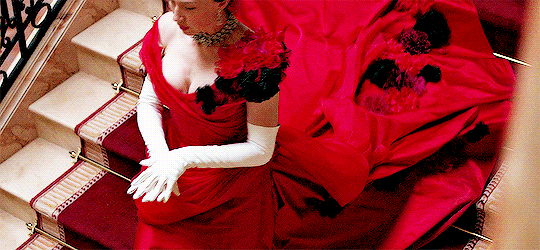
This is a new set of posts focusing on the period of time stretching from the late 19th century to the early 20th Century right up to the start of WWI.
I'll be going through different aspects of life. This series can be linked to my Great House series as well as my Season post and Debutant post.
Today will be focusing on the rules of clothes with this time period.
A Cut for Every Occasion
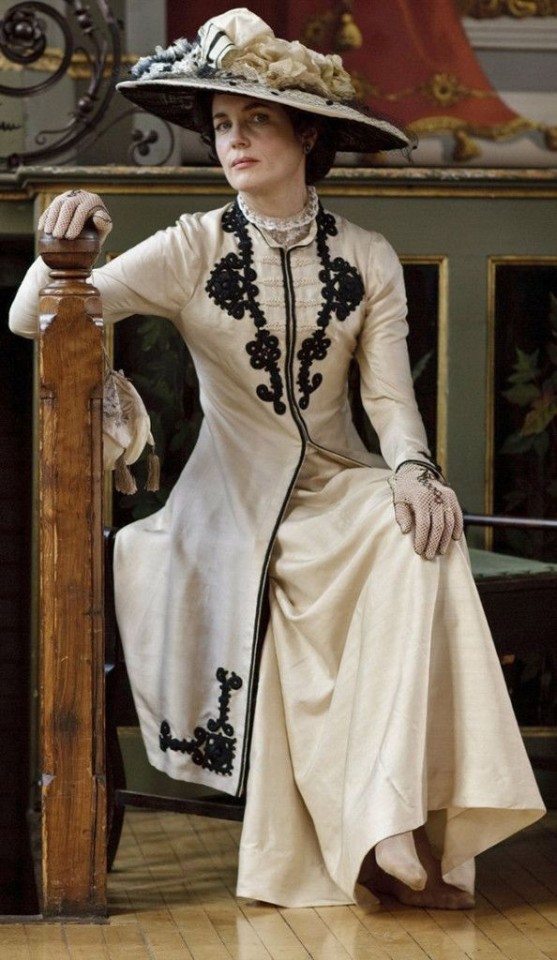
As you may know, the wealthy elite and their servants lived extremely regimented lives and every aspect was governed by careful rules. They would be expected to wear the right outfit at the right time, every minute of the day. Any misstep would be noticed at once and be subject to scruntiny.
In the circles of the elite, one would be expected to change for every occasion. One simply wouldn't wear the same outfit they've been lying around the house in to attend tea at somebody's house. Fashion in this era was dictated by the clock and by the event diary of the wearer.
Ladies

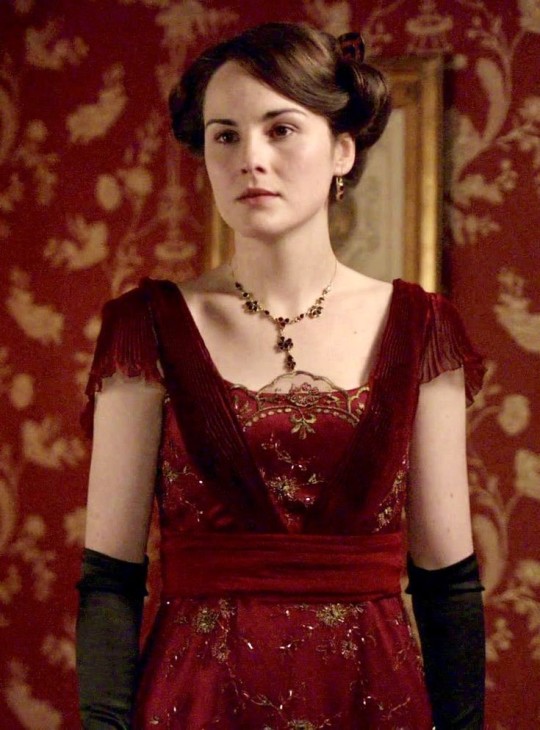
Women of the upperclass would be expected to change at least six times a day. When she would rise for a morning of repose around the house, she would simply wear a house gown or a simple blouse and skirt. If planning a morning stroll, she would change into a walking suit which is a combination of blouse, skirt and jacket along with her hat usually of tweed. If running errands or paying a visit to friends, she would wear another walking suit. If riding, she would wear a riding habit and a hat. If hosting tea or taking tea in her own home, she would change into a tea gown with is a lighter more airier gown more comfortable for chilling in. If attending a garden party, one wears a pastel or white formal day gown accompanied by a straw hat and gloves. For dinner, she would change into an evening gown which would be more elaborate and show off a little more skin than her day wear. After dinner and ready for bed, she would change into her nightgown.
Female servants had an easier time of it. A housekeeper and lady's maid would simply wear a solid black gown for the entire day. A cook and kitchen maids would wear a simple day dress for working with an apron. Housemaids would usually wear a print dress with an apron and cap, changing into the more formal black and white attire you would associate with a maid.
Gentlemen

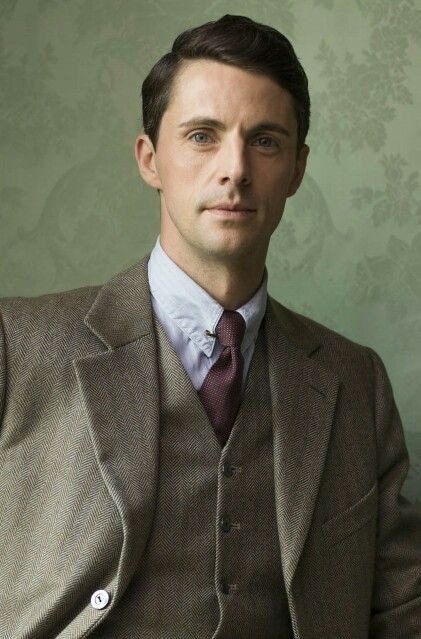
The gentlemen had an easier time but they too were subject to changes throughout the day. Men were expected to wear a suit. The most popular day time suit was a sack suit. These were comprised of plain and loose fitting jackets, worn over a starched shirt with a high collar, waistcoat and straight trousers with ironed creases. These suits were exclusively wool with cheaper ones made of a wool and cotton blend. Grey, green, brown, navy were usual but sine younger men preferred louder colours such as purple which was a trend for a time in the 1910s. These suits were worn about the house or in the city accompanied by a coat. Men would change into tweed if shooting or walking. For garden parties, a gentleman would wear a light coloured suit, usually white and a straw hat. For dinner, a man had two choices: his tails or his dinner jacket. A dinner jacket was for less formal suppers say if dining at home. This was a collection of a jacket, trousers, waistcoat, a bow tie, a detachable wing-collar shirt and black shoes. Lapels of these jackets were edged with silk or satin. Tails were worn at a formal dinner party, at White Tie events. This was made up of a tailcoat, white piqué waistcoat, a starched dress shirt with a pique bib and standing wing collar with a white bow tie. Trousers were lined with trim to hide the seams.
Male servants were soared changing. Footmen would wear their livery around the clock which would resemble white tie to a certain extent or mimic court dress of palace servants. Butler's would wear a variation of a gentleman's evening suit throughout the day. When a male servant is dressed, he usually stays that way. However, a valet or a footman may be taken to pick up during shooting parties where they would wear tweed walking suits.
Jewellery
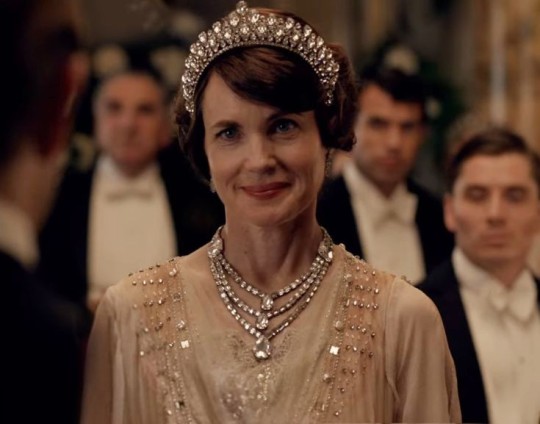
Jewellery was an important sign of status in society. Upperclass women of this time has access to untold caches of sparklers but there were rules concerning their use and meaning. Earrings were usually clip ons as women of high status would not pierce their ears. Simple, understated earrings were worn during the day with more ostentatious sets were worn in the evening time. Broaches were popular at this time, usually worn at the throat of a gown or blouse or walking suit or affixed on hats. Large stoned rings were worn over gloves while slender bands were worn under. Jewellery was intricate and understated amongst old money whole the nouveau riche went for chunkier stones and larger settings. Tiaras were only worn at White Tie events, held after six pm and almost never by unmarried girls. One would not wear a larger tiara than that most senior lady present. Men would wear tie pins, cufflinks and pocket watches to match any occasion be it for a jaunt on the town or at a formal evening party.
Hats
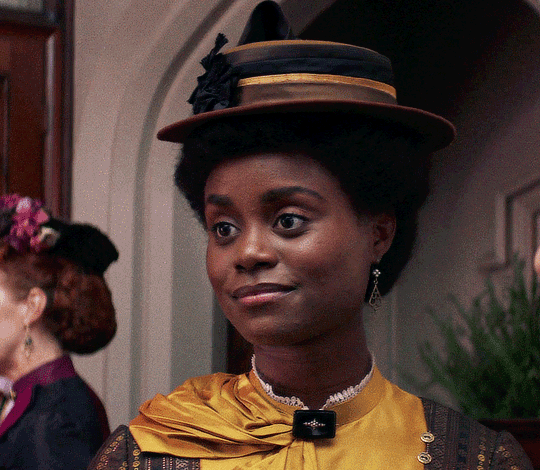
Hats were a staple in this period. Anybody respectable from any class wouldn't venture out of the door without a hat.
Men would wear hats when heading out but always remove them when entering a building, and never wear one without removing it for the presence of a lady. The bowler was seen as more a servant's headwear while a top hat was reserved for gentlemen. Flat caps would be only seen on gentlemen at shooting gatherings or in the country, they were popular among the common class for any informal occasion.
Women had more stricter rules concern hats. Hats for women were more a day accessory worn while out and about. A woman would not wear a hat in her own home even when entertaining and nor would any of the other female occupants if joining the gathering. A woman would not remove her hat when attending a luncheon or tea or any activity. Hats were held in place by a ribbon or sash tied under the chin or by a hat pin, which is essentially a large needle thrust through the hair. This was the period where women's hats became more ornate and rather large, leading to some critisism. Among servants, housekeepers and lady's maids would not wear a hat while indoors and working but a housemaid or cook or kitchen maid would cover their hair with a cap with housemaids changing into a more elaborate one come evening time. Male servants would not wear hats unless travelling or outdoors.
Gloves

Gloves are a staple in this period and worn only at the opportune time. Among servants, only footmen would wear gloves and usually only when serving. Butlers would never wear gloves. Female servants did not wear gloves.
Men did wear gloves, usually woollen or leather while outside or riding gloves when out on horseback.
Women wore gloves whenever outside. Day gloves were usually wrist length, with evening gloves stretching to the elbow. During dinner, evening gloves would be removed at the first course and laid across the lap, replaced at the last course when the ladies leave for tea and coffee after where the gloves are then removed again. Gloves are always worn when dancing and at the theatre or opera. If one is sitting in ones box and sampling some chocolate, one can remove their gloves for that.
Hair and Makeup
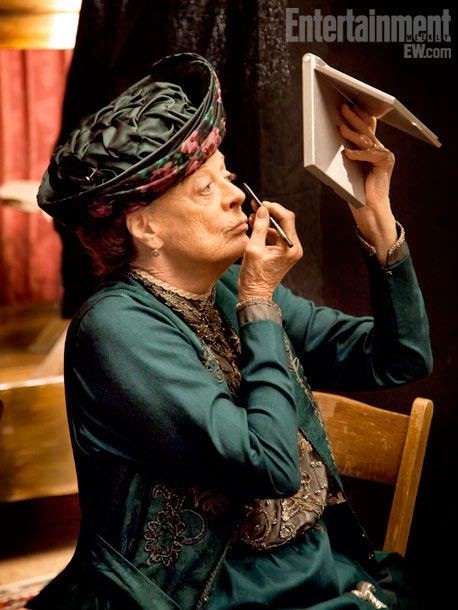
Make up was a no-no amongst the upper crust and for their servants in England and America, as it was seen as licentious but in France, the use of rouge was accepted. Perfume and cologne were acceptable but excessive use was frowned upon.
Hair was dressed by one's lady's maid. Bouffant updos were popular in this time period for married women. During the last years of this period, women began adopting the 'bob' but this was seen as radical and sometimes scandalous. Unmarried girls could wear their hair down, often with accessories like a bow to adorn their tresses. Servants would always tie up their hair and never be seen with it down or uncovered (though this depended on their job).
Men would comb their hair, slicking it back for dinner. Most men were clean shaven but if they wore beards, they were usually well groomed. Hair was kept short for grown men and teenagers but young boys may wear their hair longer whilst in the nursery.
#This bitch loooonnnnggg#Etiquette of the Edwardian Era and La Belle Époque series#Fantasy Guide#Early 20th Century#late 19th century#Great houses#writing#writeblr#writing resources#writing reference#writing advice#ask answered questions#writing advice writing resources#writers#Writing advice writing references#Writing references#Historical fiction#1900s#1890s#Fashion
574 notes
·
View notes
Text
Writing Subplots
Who doesn’t love a good subplot? Some of my favorites books are the ones that have super interesting subplots because who doesn’t love hearing about that secondary character development arc or those lovely side characters with the inevitably doomed romance? What’s not to like? But, subplots can often be one of the hardest to write and the most misunderstood storytelling elements. They aren’t part of the main narrative thread, so they can’t overtake it, but they also need to have their own story arc separate from the main plot. It’s a delicate balance that can be kind hard to strike, because subplots aren’t just secondary plot-lines, they have to serve a narrative purpose and engage with the story’s central conflict.
First, let us define some different kinds of subplots
Mirror Subplot: A subplot where a side character experiences a conflict that mirrors the protagonist’s main conflict and gives the protagonist the insight or motivation they need to resolve their own conflict.
Romantic Subplot: The protagonist’s relationship with a love interest complicates their journey to resolve the story’s central conflict.
Parallel Subplot: a subplot where something seemingly unrelated occurs at the same time as the main plot and then all of a sudden the two plots collide towards the end of the book.
Complicating Subplot: a subplot where a secondary character’s actions actively complicates the protagonist’s journey with the central conflict
Foil Subplot: a subplot where a secondary character experiences the same or a very similar conflict as the protag but wants to resolve that in a different way (this contracts or creates a “foil” that highlights the protagonists qualities and characteristics)
There are a lot more different kinds of subplots, but these are some of the most common, so here are some tips for writing subplots!
Is That Necessary?
This is the first question we should ask ourselves anytime we add anything to our stories, but especially subplots. Sometimes, authors (meaning me) will get to the end of writing their first draft and realize that they are not anywhere close to their goal word count. To remedy this, they will just throw in a cute little subplot. Unfortunately, friends, this does not work. The best, effective subplots should be integral to a story’s central conflict. If you can remove your subplot from the story without their being a big impact on the central conflict, then the subplot doesn’t really serve a strong narrative purpose. We most often see this problem arise in romantic subplots. Authors will just throw in a romance or the dreaded love-triangle as a subplot for absolutely no reason. I’m the first person to admit I love a good romantic subplot, but I also like it to be there for a good reason. That is why the Hunger Games will never go out of my top five all time books/series because despite what a lot of people think the romantic subplot in that story is essential. Katniss and Peeta’s love story is the reason they both survive the Games which is the central conflict of the book. It works perfectly, and if you want a good example of a subplot done well, look no further.
Keep the SUB in Subplot
Honestly, sometimes the subplot really is better than the main plot. That’s not necessarily a good thing, but I think we have all read a book where the main plot just drags and you just can’t wait to get back to your favorite side characters and their little adventure. But, a good subplot shouldn’t steal the limelight from the main plot. It should enhance the main plot and maybe add a layer of complexity but never overshadow. Going back to my example for the day, the Hungers Games does a really good job of this. I read something once where someone said Katniss’s romance overshadows the Games and the Rebellion, and I was like, did we read the same book? If you go back and read the books, Katniss doesn’t think about her romance with Gale or Peeta all that much. She’s mostly thinking about her own survival and the survival of her family. Both of which relate directly to the main plot. We never forget about the romance in the book because it is important, but in my opinion, it never overshadows the main plot of the Games and the Rebellion even in the first book where it’s more heavily featured.
But, Its Still A Plot
On the flip-side of that, even though the subplot shouldn’t overshadow the main plot, it still needs to follow its own narrative arc. This is where a lot of new author’s get lost. A subplot is way more than just a short conversation or a quick event that inconveniences or helps the protagonists. All your subplots need their own beginning, middle, and end. Make sure that you definitely developed all of your story’s subplots accordingly. That includes paying attention to all of your characters’ goals, motivations, and the conflict that they experience. Generally when I’m in the development stages of the subplot, I develop it the same way that I develop one of my main plots. While they do not necessarily need the same attention or development as your main plot, developing them with the same goals in mind will only help you in the long run!
#writers#writers on tumblr#writerscorner#write#writing tip#writing tips#writing advice#writing plots#writing subplots#writing resources#writing resource#writing reference#writing references
2K notes
·
View notes
Text

I really need this to happen. Is there one?
#twt#twitter text#textposts#ao3#writing references#writing#fanfiction writer#fantiction#txt#txt post#harringrove#i wish i was good at this
1K notes
·
View notes
Note
Hey Res! Please ignore this ask if it's too troublesome or bothersome
I saw you had an guide for non-drikers writers that wanted to write about a character who drink. I was wondering if you could the same about guns?
I read synchronicity and I loved it how you used Jason's knowledge with guns to control the narrative and pacing. I don't know if you have actual technical knowledge on handguns (I think it's a no? But maybe you do?) But any tip is nice
Thank you a lot 🩷
Hi anon! This is such a fascinating question and I hope I can provide a somewhat plausible answer. I am familiar with some guns and have shot a few in my lifetime, but I am far from an expert.
Some things I think writers need to keep in mind while writing their firearm-related scenes. For clarity, I'm just going to call them guns below.
Are you thinking of a specific gun? Make sure you know its full name but ALSO make sure you know its nickname. Your character might think of it as "the Berretta" instead of its full name, etc.
What does your gun fire? Does it take shells, bullets, cartridges, etc? Shotguns, for example, don't fire bullets. That's a common mistake I see.
How do you reload said gun? Is it easy? What parts of the gun do you have to touch? Reloading a shotgun is MUCH different from reloading a handgun, for example.
Most guns get hot and release gunpowder residue when shot. They're LOUD. You can have several cascading things happen to a character who fires a gun or is near a gun when it fires: ringing ears, the smell of gunpowder, the hot feeling of the gun's muzzle, etc.
Even the best sharpshooters miss shots. IRL shooting is HARD, especially when moving. Different guns have different benefits to shooting style, stance, targets. Firing a handgun willy-nilly will rarely result in accurate shots, even if you dual wield (which is silly, this is SO hard).
Stance MATTERS. If you've ever seen Hannibal, there's a scene where Will talks about his choice of shooting stance with Beverly. They bicker over Isosceles and Weaver, which are two standard stances. One uses a triangle between your arms and the gun to brace for the kickback of the shot, while the other moves that brace to one side with a different grip. Will eventually chooses the latter stance because of a past shoulder injury.
(GIF of Will struggling with his original isosceles stance)

If a gun isn't properly braced when fired, it will kick back and hit you. Sometimes in the face. Yes this has happened with me and a rifle. My first day shooting cans, I had a huge bruise on my face AND on my chest where the rifle butt kicked back.
If your gun uses bullets, there are different calibers. If you've ever watched Mythbusters, you can see why caliber matters -- it depends what or who you're shooting. Are you trying to penetrate armor? Are you sacrificing accuracy for power? Different guns use different calibers for numerous reasons, and guns can be altered to use other ammo as well.
With respect to discussing caliber while writing: It's all VERY complicated if you don't know guns, so make sure you're not giving too much detail if you can avoid it. That's a very easy way to spot a lack of experience with guns, in my experience. Your reader doesn't need to know the caliber just because the character is shooting a gun -- but in an autopsy, sure, the caliber is relevant.
You will lose your hearing eventually if you fire guns close to your ears unprotected. It's not sexy, and it also causes something called tinnitus. The real pros wear ear protection.
In terms of realism for writing, here's a couple rapid fire busted myths: You can't dodge bullets unless you're superhuman. Bullet wounds to the legs/arms/shoulders can absolutely still be fatal. Cardiac arrest caused by being shot is usually fatal, and CPR doesn't really help on its own. "Running out of shots" depends on the gun AND the modifications someone has made to it. You can't always tell just by looking at a gun what it will do. Silencers are rarely "silent" and are heavily regulated.
Injuries: Some bullets tear through bodies. Some aren't high enough caliber to do more than go in and lodge in some tissue. Some fragment and bounce around in weird ways. Depending on how gruesome you want to get, there's a lot of different ways to describe gunshot injuries. I've always been the kind of person to google images for better understanding, but I understand that's not for everyone. I think NYT or WaPo did a good piece on traumatic gun injuries a few years back, complete with an interview with an ER doc from Chicago (?). One thing I learned there -- sometimes people lose their legs, or both legs, after being shot in their leg.
In terms of describing how someone uses/fights with guns, I know the John Wick movies are a little cheesy, but they are staged by people who REALLY know their guns. They talk about what he's using usually before the scene starts, and there's very few frills when it comes to stance, firing, etc. John does a cool trick in the first or second movie where he ejects a casing one-handed away from his face, a notoriously hard maneuver that most people usually do with two hands to avoid getting burned. I highly recommend watching the John Wick movies for blocking ideas.
Which reminds me -- holding a gun sideways is a terrible idea. For many reasons. Stance, casing ejection, stability, etc. Someone can use it against you.
Never point a gun at something you're not willing to shoot. Well-trained characters should follow this rule religiously. If they were soldiers, agents, etc, they will know this rule.
Similarly, multiple people with guns will "clear" a room before entering. They will be trained for something called crossfire, which is when someone is downrange of their gun and could potentially be shot. A group of characters bursting into a room without clearing their shot is a nightmare. This is how people shoot their friends or random civilians.
I hope someone more knowledgeable can add onto this! These are just some big things that stick out to me when reading. I highly recommend checking out Mythbusters, John Wick, and even Hannibal for some semi-realistic shooting references. Good luck!
#asks#anon#fic writing#tw guns#tw firearms#tw discussion of guns#myfic#theresurrectionist#writing#fic background#writing references#writing reference#writing research
88 notes
·
View notes
Text
Writing Asexual Spectrum Characters
By a gray ace who occasionally writes for funsies.
I get the feeling people think writing an asexual spectrum (acespec) character is easy. Easier than writing a straight-up asexual character. After all, many people under the ace spectrum can feel sexual attraction. Plenty are cool with being in a sexual relationship. So, just have the character mention they’re gray ace, or an asexual who enjoys sex, and leave it at that.
I’m not discouraging any allos from writing acespec characters, quite the opposite! But there’s a reason acespecs who do feel sexual attraction, or do want sex, still call themselves some flavor of ace. There are certain things gray aces go through that an allo might be unaware of. Like, the experience of feeling sexual attraction.
An allosexual character (adult ones anyway) tends to view sexual attraction as this natural thing that just occurs. They seem to be used to it, even though there’s usually a Big Deal about it being made in the story. But that Big Deal is moreso related to the character they’re sexually attracted to. And the situation that puts them in with that character. The fact they’re experiencing sexual attraction itself though, isn’t a Big Deal.
Most acespecs don’t work like that. An acespec experiences it rarely, weakly, or under specific circumstances.
An acespec who experiences sexual attraction rarely, is going to make sexual attraction itself a Big Deal. Since it’s so rare, it’s very off putting. It confuses the shit out of us. We don’t know what to do. We don’t know what’s okay and what’s not okay. What’s “normal” and what’s not. We are lost at sea! If this acespec character is one who experiences it rarely, the experience of feeling sexual attraction itself is going to be a Big Deal. Not to say the Big Deal isn’t also the situation that attraction puts the character in. But we’ve got a Big Deal on top of an already Big Deal and you’re gonna be drowning in conflict!
It’s likely to be a similar case to acespecs who only experience it under certain circumstances. Demisexuals, for example. For the most part, demisexuals function as asexual until they develop a special bond for a person and then BAM! They get smacked in the face with a big ol’ heaping pile of sexual attraction. They are also lost at sea, depending on how often they experience sexual attraction.
Acespecs who experience sexual attraction weakly, are going to have a hard time knowing if they’re even experiencing sexual attraction. They tend to question if what they’re feeling is sexual attraction or not. (And most the time, it’s probably not.) Maybe their libido went off while looking at a person, and now they’re trying to conjure up sexy thoughts to figure out if that was sexual attraction. Or maybe their libido did nothing, but they had a sexy thought about the person, and are wondering if that counts as sexual attraction. Maybe they actually know it was sexual attraction, but they just didn’t feel it strong enough to feel any innate desire to act upon it. Basically, this character is highly unlikely to get into any conflict involving the character of desire without some kind of outside intervention from other characters. (One exception might be to get closer to the character to figure out what kind of attraction they’re feeling.)
As for aces who don’t feel sexual attraction but still have sex? They might experience stuff like aesthetic, sensual, and/or romantic attraction. They’ll most likely have a preference towards having sex with someone they feel some attraction to. But they won’t feel sexual attraction for the person. They’ll likely have sex with the person because they’re turned on in general, or want to know what’s like, or they want to make them happy. Just, any reason that doesn’t involve actual sexual attraction towards the person. They’re not going to feel a need to dramatically rip the other person’s clothes off and start going at it then and there. They’ll just go along with things as they happen. They’re more likely to focus on whether they’re doing things right, or on how good the actions feel. They might think about how their partner is aesthetically attractive. Or that they’re in love with them or whatever. They may dig the emotional intimacy they’re getting out of it. If they’re easily distracted, they might start thinking of completely unrelated things. But they’re unlikely to think of how much they want to fuck their partner in particular.
We also share similar problems to strict asexuals. Even though some of us do experience sexual attraction, there’s the matter of finding someone we’re even sexually attracted to! Or, sexually attracted enough to even pursue the feelings, or share that feeling with our partners. We’re less likely to initiate sex. We’re more likely to be content going without. There’s always exceptions though, especially if the ace has a high libido. Outside of relationships, people can be dismissive of our orientations. Some might think we have a problem that needs to be “fixed,” while others might think we’re being a bunch of special snowflakes and are actually just “normal.” Some of us grew up feeling “broken” until we discovered the ace spectrum. Some of us didn’t realize we were experiencing attraction differently than allos. Some of us didn’t even realize sexual attraction was a thing.
So, all of that is worth keeping in mind as you go on to develop your acespec character and any situations you throw them in where their experiences as an acespec affects things. You’ll find that it’ll make a more interesting story than simply slapping an acespec label on an otherwise allo character.
Good luck! 💜
#asexual#asexuality#acespec#asexual spectrum#graysexual#gray asexual#demisexual#lgbtqia#writing#writing references#original posts
754 notes
·
View notes
Text
HOW TO WRITE A FINAL DRAFT
(From Someone Who’s Been Working on the Same Book for Over Ten Years)

Listen, I know what you might be thinking: “why the hell would I want advice on how to work on my final draft from someone who can’t even get her shit together for her own book?”
However, because I’ve had to re-draft my own novel so many times (Primarily due to poor outlining, lack of time and inspiration, and my own insecurities as a writer), I’ve learned a lot over the years on when to know if your book is done (or not!) and how to keep motivated.
Just a disclaimer that these are my own tips and tricks that you may not agree with, and that everyone’s writing process is different! Don’t feel pressured to do things my way if you feel like it doesn’t work for you as a writer; everyone’s experience varies, and there are always exceptions!
1. Know If You’re Ready to Start a Final Draft
Some vocabulary for writers to know:
Content editing is a form of editing that revises the overall style, substance, and content of a story.
Copyediting is a form of editing that revises grammatical, spelling, readability, continuity, and factual errors within a story.
A way I would know if I’m ready to make a final draft is if I am no longer doing major content editing on the book. This means I am no longer making major changes to the plot, characters, setting, and other facets of the book. There isn’t any re-writing of entire scenes, or major plot holes that require an overhauling of the entire book.
You know you’re ready for a Final Draft if your primary concerns are copyediting.
Of course, with copyediting errors such as continuity, there will inevitably be some re-writing required, but I personally would not want to start a “final draft” at a stage where the book’s major plot points must be constantly changed during the editing process.
This varies so much, from writer to writer; so my best advice is to start your final draft when you think you’re ready!
2. Consider Getting Some Beta Readers
Again, this is an incredibly complex process; some people like to have beta readers on their earlier drafts, while others like to have beta readers for their later drafts.
A beta reader is someone who reads a work of fiction before it is published in order to mark errors and suggest improvements, typically without receiving payment (although it’s nice to swap stories and beta read for each other!) You can find people willing to be beta readers all over, especially on tumblr!
Having a round of beta readers is a great opportunity to have unbiased eyes on your work, and to have people pointing out plot holes and inconsistencies that maybe you hadn’t noticed! It also gives you a much-needed break from writing your story, and helps you come back to it with fresh eyes once everyone is done.
I personally am waiting to finish my current rewrite before having a round of beta readers, and after they look it over, doing a draft of my own editing before moving on to a final draft.
(Things don’t work out the way you think they will, though—that’s life! Take as long or as little time as you need!)
3. Consider Taking a Break
In my opinion, the best way to start editing a final draft is doing so with fresh eyes. After finishing your second-to-last draft, shelf your project for a few weeks (or maybe a few months!) and move on to another work. Then, you can come back to your story as if you were a new reader, and catch mistakes that you may have missed if you were still in the groove of writing!
This can sometimes be dangerous for writers who struggle with inspiration and getting back into things, though, so do whatever works best for you!
4. Tips to Keep Inspired
How to Overcome Writer’s Block
How to Write Consistently
Writer’s block and lack of inspiration will be your greatest enemies on your final draft! Oftentimes, people lose steam once they see the finish line is ahead. Check out the tips in the above post to help keep you on task!
5. Learn How to Stop Editing: It Will NEVER be Perfect
You are your own worst critic. You will always find something to tweak every single time you comb through your own writing; hell, even published authors sometimes read their own books and think of ways they could’ve improved certain sentences or scenes! Understand that “Final Draft” does not mean “Devoid of Flaws.”
Sometimes, the best thing you can do for your book is to know when you need to stop overworking it and send it out to the world. Writers who struggle with liking their writing can find this especially difficult, which is why it can be helpful to have beta readers or a writing buddy who can put their foot down and say: it’s done! You’re ready!
Hope this helped, and happy writing! I believe in you!
#writing#writing tips#writing advice#writing help#writing reference#writing resource#writing resources#writing references#creative writing#final draft#writeblr#booklr
118 notes
·
View notes
Text
dynamics to write instead of romantic
obviously there’s nothing wrong with romance, i love reading it, it’s so sweet and heartfelt and just...there’s something so precious about giving yourself so completely to another <333
but let’s not forget that there are more dynamics out there than couples. so many wholesome friendships and parental dynamics and teachers and students and ahhhh
best friends at the beginning, closer friends at the end
best friends at the beginning, enemies in between, back to friends but now there’s a “we gotta regain trust” vibe
reluctant/troubled parental figure (mentor, teacher, adoptive parents, etc.) and child/teen
“i wish they were my real family” aka your real family sucks and you hang out with people whose families seem amazing </3
weird old person (probably with a dark secret) and a young, innocent, curious child
mentor/parental figure turned villain (or plot twist villain), leaving kid/teen behind, confused and hurt
just good ol fashioned siblings
twins <333 or triplets ahhh
older boy and younger boy becoming friends, being all protective and older-brothery <3333
stepparent being introduced into an existing family, and trying to be accepted and get along with kids and whatnot
#writing#characters#creative writing#character dynamics#found family#brothers#sisters#siblings#things for characters#writing reference#writing ideas#writing inspo#writing inspiration#writing references#writing ref#ref#<3
626 notes
·
View notes
Text
Writing a Passive Protagonist?
(by @septembercfawkes )
One of the most common pieces of writing advice given in regards to protagonists, is that the protagonist needs to be active. In fact, the origin of the word “protagonist” comes from the Greek words “first” and “one who contends for a prize, combatant, actor.” Nonetheless, many writers struggle with passive protagonists—they may not understand why passive protagonists are a problem, what a passive protagonist even is, or how to make them active. In this article, I will give you some tips.

Characteristically Passive Protagonists
Not everyone is an innately motivated go-getter. In fact, some people want nothing more than to stretch out in a hammock with a cold beverage and watch the world go by. Others may even be considered lazy. A protagonist may have these same characteristics. They have little interest in getting anywhere else in life, and they’d rather other people solve society’s problems.
They may only act when the stakes get serious enough—when they want to avoid a big bad possibility, or when something threatens their carefree lifestyle, or when an opportunity comes along that is too good to pass up.
When this happens, they often turn into reluctant heroes.
Just because a protagonist prefers to be a passive bystander, doesn’t mean they actually are in the plot.
When people advise against passive protagonists, they are advising against protagonists who are passive in the plot—not protagonists who would prefer to do nothing.
Protagonists Who are Passive in the Plot
A protagonist who is passive in the plot is one who is largely letting the story happen to them, and they aren’t doing anything to make the story happen.
The protagonist doesn’t take any real action to address the main conflict. He doesn’t have wants or goals, or, if he does, he doesn’t make concrete, measurable plans for how to obtain those things. He doesn’t take action to get something.
Instead, he is simply a target of the next attack from the antagonistic force.
All he does is wait for the conflict to pass (or maybe for the antagonist to show some mercy).
Many beginning writers find themselves writing passive protagonists, thinking that this passivity somehow makes the character more likeable by making them more sympathetic.
In reality, the most sympathetic pains and conflicts come as a cost to getting a goal. It’s the struggle to get somewhere, despite the antagonistic forces, that is most meaningful.
We all have bad things happen to us, and it’s unfortunate.
But when someone chooses to pursue something that requires hardships as a cost . . . that pain is more meaningful.
A passive protagonist is also more difficult to get invested in.
It’s hard to care about someone who does nothing.
In contrast, it’s easy to care about someone who is struggling to do “everything.”
Is My Protagonist Too Passive in the Plot?

If a bystander character swapped roles with my protagonist, would the direction of and outcomes in the story change?
Is my protagonist making decisions that influence what happens next?
Does my protagonist make choices that affect the main conflict?
Is my protagonist creating meaningful changes to almost every scene?
That last one may seem a little over-the-top to some people, but trust me, if you have consistent, solid scene structure, your protagonist should be making significant choices in nearly every scene.
Turning Passive Protagonists into Active Protagonists

Give the Protagonist a Goal.
Goals are the first ingredient of plot, because if the character isn’t trying to accomplish anything, then what happens doesn’t really matter all that much.
Almost always, the protagonist should have a want that manifests in a concrete goal. But the goal needn’t be huge and aspirational. It just needs to be significant and attainable. A goal such as drinking water can feel important if the character is at risk of dying from dehydration. A want or goal that isn’t attainable—that the character can’t take action to get—is little better than having no goal.
It should be a goal that the character can make and carry out plans for. Otherwise, it’s really just a wish.
At the most basic level, there are just three types of goals.
Obtain something
Avoid something
Maintain something
And if you pick the last one, something has to disrupt the maintaining for there to be a story (at which point, the character then tries to return things to “normal”).
Include Significant Stakes.
Stakes are what are at risk in the story. But I find it most helpful and most accurate to think of them as potential consequences. What good things will happen if the character gets the goal? What bad things will happen if she doesn’t? These are some questions to ask to come up with relevant stakes.
If you are struggling with a passive protagonist, there is a good chance that the stakes aren’t big enough yet. Almost anyone will take action when the potential consequences get serious enough. A self-absorbed protagonist may not stick his neck out to save his neighbor from bandits, but if the bandits were threatening his life, he’d take action and carry out a plan.
If the stakes are already significant and the character still isn’t acting, chances are that you have the wrong stakes. You need to think about what matters to the character. What can you offer her that will get her to act? What can you threaten to take away?
Pressure the Character to Make Important Choices.
Passive protagonists often aren’t exercising their agency. Active protagonists are. Once there is a goal, with stakes, the story should put pressure on the protagonist to make important choices about how to move forward. Often the character will be pushed into a crisis. A crisis is where the character has to decide between two opposing paths, and the decision is difficult because each option has significant stakes.
For example, say the character’s goal is to find a cure for her best friend’s fatal illness. She takes action by visiting a prior enemy who knows where the cure is. The enemy says he can get her the cure, if she swears herself to him. Our character is now in a crisis. Get the cure to save her friend, and be a slave to her enemy? Or don’t get the cure and have her best friend die?

Whoever your protagonist is, makes sure they are active in the story by implementing these elements.
Learn more at https://mystorydoctor.com/
185 notes
·
View notes
Text

#writers#creative writing#writing#writing community#writers of tumblr#creative writers#writeblr#writerblr#writing tips#writblr#writing advice#references for writers#chekhov's gun#anton chekhov#literary principle#creative writing tips#writer things#advice for writers#writing references#writers corner
579 notes
·
View notes
Note
do you have any good references for kiss scenes 🥲
of course!! let me know if you want/need more :D
fics for reference: good kiss scenes
the art of missing the ground - not too exaggerated of a kiss, feels very natural, sweet
paths are made by walking - a bit spicier ig?? i dunno these are more lighthearted
where you go, i will follow - kiss has meaning!!! kiss as a plot device!! good example of more 'negative' reasons ig (still soft tho)
but you saw enough - more climactic? also kinda spicier soooo...? (help me)
pick me up and dust me off - literally so soft you will get cavities. top tier fic. natural kiss too, not too exaggerated
shrapnel - good example, shows that not every relationship has to begin with or star a kiss
(ain't nothin' like) the real thing - definitely spicier. nice example of buildup and that good ol climactic approach where you're literally just screaming 'oh my god kiss already'
listen (he's already told you five times) - another good example of when kissing is not the only form of love!
i counted days, i counted miles - excellent buildup, the kiss has... meaning? it isn't just a kiss yknow it has emotional depth
but we can try - also has meaning. i'm not a huge fan of the trope where like 'oh they aren't in love/dating until they kiss' but this fic actually writes it really well!
#first off#you're all welcome#because this was torturous#jk jk love u all#list#references#writing references#fic recs#fic rec#sobbing#never make me do this again#my aspec heart is dying#jk jk#hashtag worth it#are 90% of these marvel?#yes#do i regret it?#no#NEVER#also#in case you were wondering#i used the word kiss eleven times in this post#eLEVEN TIMES#11#whole#times#i am unwell /lh
22 notes
·
View notes
Text
Writing Scenes Out of Order
Gonna be honest with y'all, I have never ever written a story completely in order. I am actually incapable of doing that. Even though I write the most detailed outlines known to man before I even think about writing, I still can’t write the scenes in order. I swear by this because I sincerely believe that writing scenes out of order increases my productivity which I’ll talk about later. Even if you haven’t done this before, I recommend everyone try it at least once, so without further ado, here are a few reasons that you should write your stories out of order.
You Can Write The Ending First
When you write your scenes in order, generally that means that you’re going to write the ending last. In my experience, the ending is one of the most important things in your story, so I recommend that even if you write everything else in order, always write the ending first. Writing the ending first always gives you a light at the end of the tunnel. It gives you a destination to eventually reach. Even when you feel like your story is going absolutely nowhere, it allows you to go back and see what you want the ending to look like from the beginning which should help your motivation and hopefully lessen that pesky writer’s block!
Oh, Those Continuity Issues
Continuity issues are the absolute worst. I can never seem to remember the way that I described stuff at the end of the book when I’m writing everything back at the beginning. One thing that does get frustrating about writing scenes out of order, is keeping up with continuity like what season it is, what characters have already met, and even who is alive and dead at certain points. Writing scenes in order eliminates these issues because you are writing everything in the order that it happens. I would most definitely recommend keeping an outline or at least a sheet of notes when you’re writing scenes out of order, so that you can keep yourself organized and lessen the continuity issues that you have to go back and fix in later drafts!
You Can Follow Your Inspiration
I plot every scene out extensively, but if I do have an idea for a scene, I immediately write it down and worry about where it fits into the story later. For me, this increases my motivation because at least I'm writing something even if it wasn't in my original outline. Every story has scenes that aren't the most interesting, and as writers, those can be the hardest scenes to write. Especially if you write all of the interesting scenes first, you won't have anything to look forward to when you're struggling through the more transitional parts of the story. This is just my opinion, but whenever I write in chronological order, my motivation goes down a lot. I like writing whatever scenes I want to write instead of writing what comes next in the story. Knowing that I can write whatever scene I want to next makes me super excited about writing
Sprinkle In That Foreshadowing
Y’all know how much I love me some well done foreshadowing. It’s simply one of the best things about reading and writing. But, writing foreshadowing can be really complicated if you aren’t sure how the story ends or even how the foreshadowing will fit into the story later. Because I normally write the ending scenes first, when I finally get around to writing the beginning scenes, I can easily sprinkle in little bits of foreshadowing or allusions to later scenes. It also helps me not overly foreshadow anything because I can go to the end and make sure I'm not doing too much.
#writers#writers on tumblr#writersofinstagram#writerscorner#writing#writing tips#writing things#writing tip#writing advice#writing resources#writing resoure#writing refernece#writing references
2K notes
·
View notes
Text
MCU Asgard Canon Observation Research [Part 1]

Firstly and before I even start in on the subject, keep in mind that this is what it says: a collection of research into actual Canon Lore from the Marvel Cinematic Universe: not the comics, or the Nordic lore twice removed from it.
Secondly and alongside that, also keep in mind that even back at the start of the MCU as a long term project, while the MCU is based on the Marvel comics universe: the creators made a point of making it a completely different universe: for many varying reasons, including the spaces lacking continuity in the comics over the years that the MCU as a project wanted to pursue from it's first conception.
This is a large part of why there are phases and why they were numbered from it's creation. (And yes also why my tags recently mentioning counting phases are what they are elsewhere, but that's a whole other post.. or set of them.)
These are important to remember because, I would like to avoid previous iterations of people wasting their time trying to insert comics-universe lore and more excessively into or onto this requested post purely for the sake of, well; being argumentative or just trolling:as much as possible. I do try to take some time to respond to comments and reblogs as much as possible, but I can and will ignore or yes, at times point out people unable to manage these things.. and respond as necessary.
I normally wouldn't bother to mention this except yes, that has happened before so: consider this your disclaimer.. I ain't dealin' with you if you're gonna be a trolly shit disrespectful enough of the time effort and willingness to share what research and observations I have, by shitting on it or me in your pursuit of whatever flimsy excuses might be given for any inhuman reactions posted passive aggressive or worse.
More frankly: be respectful on my posts or get lost. I don't tolerate harassment on my blog whether it's aimed at me or others. Passive aggressive or otherwise. I'll discuss stuff, am happy to have any valid references I might miss added to and pointed out. Just don't be an asshat about it, and you'll get the same from me. That's how basic-bitch Karma, and I; both work: you'll get what you give along those lines, while in my space.
The necessary now out of the way... Next!
More as a side note with that mentioned; while I may mention some meta/theory in the form of the most probable (as that's how my meta in particular is formed) it is again: based on the facts of the canon lore and contexts confirmed presented in it; visually, in dialogue, and out of the mouths of the very people who made all that themselves, at the time that lore was given to us on screen: and will be mentioned as the theory and supposition that is 'meta' rather than 'canon'. I have gone out of my way as a fan of world, universe, and character building as a part of the creative process in particular: to watch, rewatch, rewatch again and again, and hunt down all this stuff (often lol purely out of my own curiosity.) All in all Meta is theory, Canon is story/film-established fact; and I do try to keep a clear line between the two of them. The early world and character building in the MCU has always been interesting enough to me alone, to do all that with my free time.
And that's especially true with Asgard in particular, as a main story driving force in one form or another as far back as 2010 when both Thor and CA: tFA's scripts were being filmed and their sets/settings picked out and created.
Final few bits before we get into it..? As Asgard lore (and even a lack of it's presence at times) is directly and appropriately attached and or in relation to the lore of several races, species, and massive events in the entirety of the MCU's first three phases.. I will be touching some of those cultures and places too, where important. Probably not in this particular part, but yeah. It's gonna happen.
As with the research post into Loki and his year of absence prior to Avengers 2012: (yes that's a link to an ask that contains a good chunk of info and years of interviews on that particular subject) this might not be an entirely complete compilation: for the same reasons. As I said, i didn't just watch, I rewatched repeatedly from differing personal mental angles: not just three or four times, but and as I wrote my own fanfiction.. I would also re-watch once or twice just prior to fleshing out an outlined story of my own to refresh my memory, seek out interviews official and otherwise from the creators and actors who made that lore and put it on screen for us to enjoy as part of the stories we enjoyed (or not, depending lol) and well.. the resulting organization of the whole outside of this post is less than comprehensive for anyone else. You can see the explanation for how that happens in the foreword of that thread if you're curious.
As a result, I may or may not exclude the actual interviews if this gets too long. Much of the visual in this first part especially are pretty self explanatory, as I did find some of my dissection pics too.
All said (I think? Gods I hope so that was a lot wasn't it? XD) and as suggested/requested recently in discord?
This one is gonna be expansive.. and hellaciously so: so grab your drinks and your snacks and still be prepared for this series of posts to be going for while (not kidding, may be compiling this properly between jobs for weeks) so yeah..

Here we go again!
The major forgotten fact of Asgard's depiction in the MCU is this:
We the audience are only shown a very tiny fragment of Asgard as another separate planet in space, and: they do show us we're missing as much, from the very first film.
That gif directly from the movie I used at the top? I'm using it again, because...

..look at that.
With topography, perspective and size in mind.
That tiny golden triangle in the middle is the Palace at the center. The little golden bar along that tiny portion to either side? Is the city attached to it proper, with the Bifrost, and as far as we've seen the 'Heroes Road' (as soem are calling it) and city walls cupping the Bifrost Bay directly facing the camera.
This is a space shot (of course,) and that tiny itty bitty moving spec that is still shrinking as it gets further from our perspective and closer to Asgard at the bottom, is the Bifrost in use.
And, they do give us a few views of that as early as five to six minutes into the first movie in 2011, as seen in the first clip below. I've set it to share at the first view of Asgard itself.
Hopefully that works. If not, the timestamp you're looking for is 2:04.
I recommend shutting off the audio, as it's a bit distracting. Trust me, we will get back to the very interesting audio from a world builder's perspective, when we get to the History and Relations section of Asgard's break down.. there are several tons, of that and in that opener alone, to examine later.
youtube
IMPORTANT!! When looking at any of these images or videos, keep in mind and look at the scale. Not just in the scene on screen at that moment, but also in reference to previous shots. Distance is a thing. The size of trees and people are a thing. This place in the MCU is much more massive than where it's very cloistered story parts take place.
This is not a city-planet like and for comparison: Coruscant, from Star Wars... though I am very aware that some people will throw out Asgard's concept art to try and 'debunk' that (yes its' been done and proven pointless in other threads).. that does also bring us to another couple of facts that slip by in their context.
In fact, you know what? I'll throw it in here right now myself:

This concept art: does still apply, if slightly adjusted with the topography and likely under ground portions taken into account.. because Asgard is the name of both the planet AND the city as separate entities of the same locale.
In other words, the concept art is VERY valid as a map of the city itself: but not the outlying locations outside of Asgard as a Capital City Proper, of Asgard as a disk planet.
And again.. they do show us this, and not just in the first film: although that first shot going into the city says as much too, being that..
A. Asgard is established as a society greatly more advanced than Earth and most others, and;
B. there are whole swaths of land (and especially mountain they like to build into) without structure between the edge panned through and the City itself. (see still image below: not the best quality but it's also in the video.)

Which.. we'll touch again a little more in a bit (and probably the biggest lol) part of this breakdown set; digging at History, Culture, and Relations.. as the fact they do prefer to build INTO their environment much more than on top of it is also shown in the shot of the canyons and canals on which not only that city is built, but even what buildings are shown outside of it on that panning-in shot.
We can see in the one above though: that while they did redirect some of the water through canals in the lower shot; they also kept and built into the natural(?*) lay of the river canyons below.
This theme is kept even before we get into the city though with the first part of the shot above the water.
Want a more visual view of the breakdowns as I do them?
Here you go, here's one example from out of my crazy folders and docs, that I made in paint back in 2013 (LOL yes I know. XD) while once again re-watching that same scene.
I would highly suggest clicking on it, as tumblr does downsize images making text on them hard to read otherwise. Crappy in-motion quality screen cap but, it was made more for breaking down the visual elements on screen for what it told us about the land, and more; on it.

----[?*] As a set of side/foot notes to that last bit and the image..
A. the top left corner yes: does reference some of where I use certain observations of canon in my own fics; and how they would have grown or evolved depending on that story. In this case, and at the time: the pink text is making note to utilize those observations in outlining Hvedrungr (Loki from Uni 0) and Flykra's (Loki from Vesti1 Uni 14) universes in particular: both of which return to Asgard at VERY different times and in different situations: while the history and culture I've been able to glean and expand on in some cases is still part of their and the location's background. As I don't have the patience to remove the text from an old paint shop cut.. I thought I would at least explain it's presence left there. These things are, ultimately connected by the culture that originated on and created them on that planet after all.. and why there's an entire section dedicated to the varied aspects of Asgard's presented Cultural, Relations, and History lore.
B. The '?' at the 'natural' mention in parenthesis above, also takes into account that Asgard is much older than Earth's culture and has to be: if only because as only three generations have come and gone over the passage of what to us is five thousand years!
(see the next installment Thor the Dark World: Bor and Darkalfheim, or just watch the movie with info gathering in mind.)
In other words, between Bor's War, and Odin's Asgardian Great Wars: we cannot be certain whether or not 1. those canyons are actually natural or the now aged result of one of many previous interplanetary wars, or 2. whether Asgard at this stage of it's showing timed at 2011 more than a millennia later, has even always been this size, given their advancement in technology and study of magic as presented OR left in question, either. For my part, as there's no conclusive dialogue from that era to state otherwise in the MCU or it's interviews that I know of, and knowing the context of Malekith and Darkalfheim's familiarity with Asgard itself during their raid to reclaim the infinity stone: I tend to veer towards a mixture of the two.
While it's very likely at least some of the canyons are indeed natural; the great age of the culture and planet both, along with the nature of Bor and Odin's rules alone as we've seen them: leaves a HUGE and LONG period of time and opportunities for some of those nasty fights to come directly to them... or even their predecessors. Which would also explain why they had that shield for the palace too. You don't build and more importantly upkeep something like that without a very good set of reasons or examples experienced, to do so after all. Much of that is meta though, however based on canon fact it may be: and as many of the creators were not asked publicly during that era, and have been dismissed or moved on to other projects since.. it's hard to know if we'll ever see a *genuine* answer from the people who actually made it all starting sixteen years ago.
Anyway, let's look at a few more shots of Asgard with that breakdown going. Some of these are all old, from as far back as about ten years ago when I first started writing outlines for the varied universes in my Lokiverse Project: but they do still hold up. theer are some from TDW in this bunch too. I heavily dissected these scenes knowing I was going to do whole chapters in multiple differing universes, and wanted to have the presented layout and feel laid out in my head, before I started adding in locations on the planet not yet shown on film. And given my first Book was already going to be DREAMS.. where Asgard has been blown to bits post Endgame? I really wanted to get it right so I could deconstruct it as many times as I and the muses wanted to. Laufeyson (Universe 10 Loki) was pretty insistent too with the opening chapters on his end focusing partially on that chase with Abell through Asgard's blown apart ruin
Sorry for the ramble of an explanation, but that's how it is and how it works over here...? XD
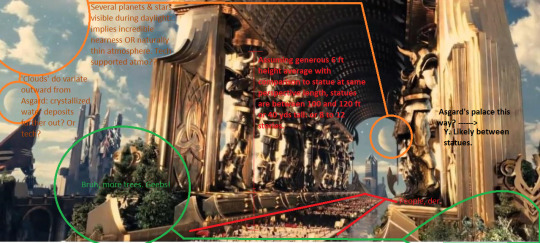
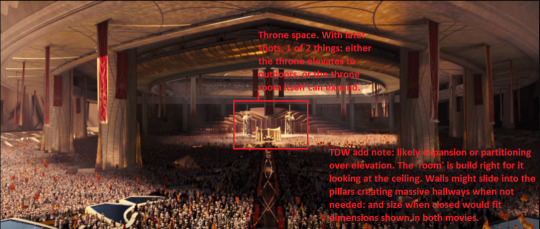
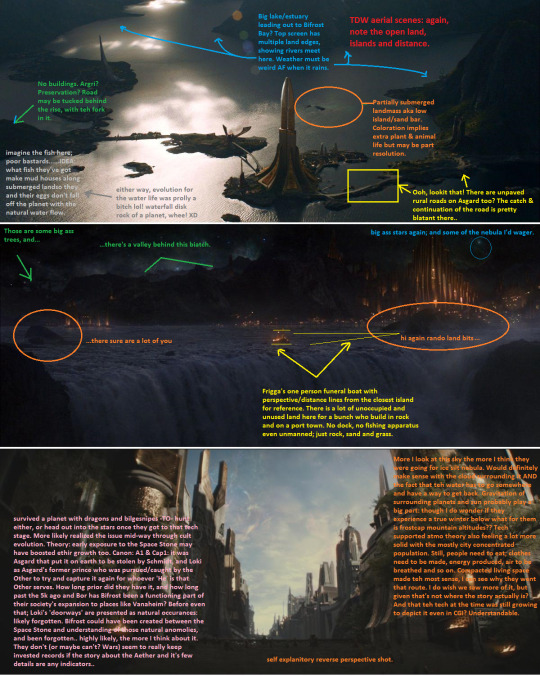
..uhmmmm. Yeah lol! When I said I watch and re-watch from differing mental perspectives..? That's what I mean. I don't usually share those at all... only the unedited pics. Genrally I will take caps or take existing raw caps and pick out piece that catch my eye. I've been told they do help put your brain in the right mode for those who have difficulty processing them in that way, like I do when in that mode. Also yes, trees and fish ...bruh. lol!
It's there, has been for years in some cases; and I'm not messing with it now.
That basic bit out of the way (doesn't sound so basic does it.) Let's backtrack a bit, specifically to Asgard's shape and the placement of it's location and the locations on it.
As I first write this, I don't have the talks I had with a few wild meteorologists and geologists back then directly on hand (as this is a part I still don't focus on too much; but:) shaped as it is, those I did talk to theorized that between the shape and placement of planets as well as the nebula they're partially inside, that Asgard may be shaped and in rotation as it is because of its' placement in it's system: or because of late interference by Asgard's inhabitants to keep it stable.
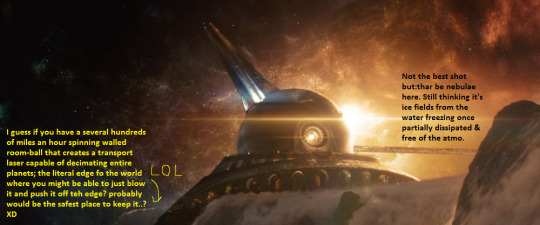
^ That one scene in particular from Thor 2011 really made my eyes pop. Not because of what's going on in it so much as trying to answer the whys and hows and what the actual fricks man: because..
Can you imagine, the conversation: trying to pitch that spinning death ball to the King there OR anywhere else on the planet before Bor or even his great grandfather?
Or, trying to talk the royalty down from the idea of putting it anywhere NEAR the palace, or other people's homes?
How about testing that house sized death-by-velocity-alone gilded mess? (Yes I still laugh thinking about that. Some poor scholar/engineer type trying to dissuade Bor's grand-daddy from building what would definitely become a giant pinball of death in the canyons and canals, if that thing ever came off it's anchors even once in the city. Good gods! lol!) Who knows; maybe that was when people started moving to Vanaheim... XD! Just (mostly) kidding.

Cray-cray thoughts of high velocity gilded pinball hell that was probably somewhere way back in the Bifrost's likely development and evolution as tech/normie science boosted by magic, and or vice versa, aside:
You probably notice I've mentioned the nebulae and the planets in their rotation more than once. And with good reason.
Backing up a bit; Asgard is interesting well before you hit her shores.
Not only is she a top-shaped disk-planet: but with the way the sky is shown: Asgard has a very interesting rotation if she has any left at all. There's very little we know, but what we do know is she is not alone in her systematic rotation either way.
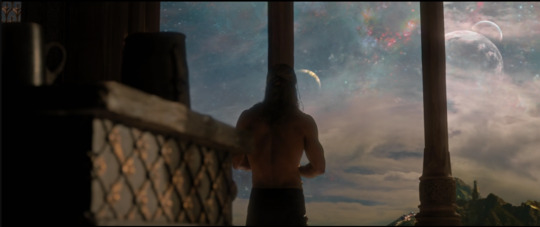
(Asgard's sky from Thor's personal Hall in Thor: the Dark World)
In fact and as seen in the screen caps above: Asgard has an incredibly close relation to at least three planets in her nebulous solar system. At least one of which is absolutely massive: massive enough that it's close proximity is theorized as being pretty likely to be the only way Asgard experiences night cycles as seen in Thor: the Dark World... mainly through eclipsing the nebulous sun by passing between it and Asgard as a planet.
Which is both cool -and- scary when you take things like degrading orbits, space debris and projectiles like comets and other space science into account.. but also very, very interesting.
It also begs the question either way: why didn't Asgard at their earlier establishment of a greater technological level, colonize or move to those planets sooner? Of course.. the first obvious answer is.. they probably couldn't, at first.
And even more probably were past trying by the time the Bifrost was built, prior to Bor's time (I say prior because we have seen Bor use it in Thor the Dark World: and on a massive scale moving whole armies, the same as his son Odin. See some of the scenes from Bor's seizure of the Aether below.)

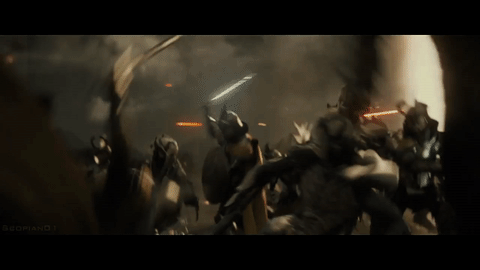
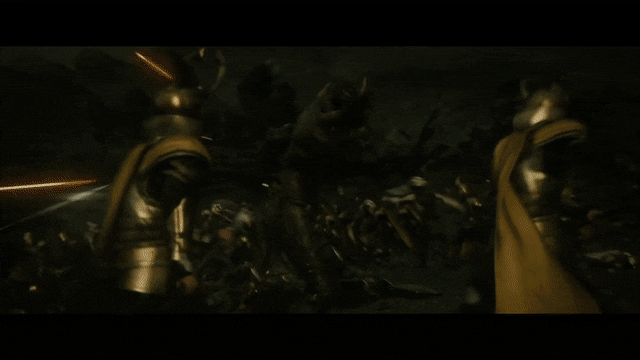
But yeah, Asgard is a pretty unique place even before you get to the water fall's edge: or questioning what kind of condensed mass it has to retain gravity at it's very small size.
Or, whether that gravity and the shape is in fact generated in some form or another after millennia upon millennia of just the Wars we do know about in their history.
(At current we know about Darkalfheim and the series of Wars including Jotunheim and Muspelheim that they call the Great Wars. While they are definitely aware of the extensive millennia of intergalactic war between the Xandarian based Nova Corps and the Kree Empire put front and center in GotG.. there hasn't been any actual confirmation as to whether Asgardians fought in that war on either side: only that they are at that stage at least loosely allied with Asgard.. if not a more separated protectorate being considered among the nine realms in the MCU.)
Why do I keep pointing out trees, and perspective; or teh size of the city in that first little gif again?
Because.. that is our repeated visual evidence of just how much of Asgard as a planet; the story did not take place in.. huge parts of the place we haven't seen. And that makes sense.
Power plants or generators, smithys, and even schools can be easily placed in the city proper, at this stage.
But what about BEFORE, they got to this stage.. because that is a thing in the MCU in regards to Asgard: and a major plot point for three movies of script running, from 2010 all the way to 2015 when Taika Waititi was hired (unfortunately, for those of us who know the root of what happened there.)
What about food, for thousands of 5000 year lifespans and their kids. And their grandkids. And.. the food for the livestock, or the wild game
Or the bilgesnipes and dragons--well we can guess what happened to the dragons of Asgard in particular actually. If they were anything like Muspelheim's; and on a planet that size..? It doesn't take much to figure out Odin, Bor and their predecessors probably couldn't excuse not hunting a predator big enough to swallow people to extinction: not for much longer than they absolutely had to anyway.
What about fibers and leather for clothes.
How about waste management, for both the city and suburban areas? Sewers? Water filtration? Factories or slaughterhouses to process it all, and the means to support those things. Everything man made, is grown, processed or made somewhere.
We know they have these things, because we know they have and make their own alcohol (fermentation of grains, fruits, and more); as well as other things to eat: displayed in both T1 and TDW.

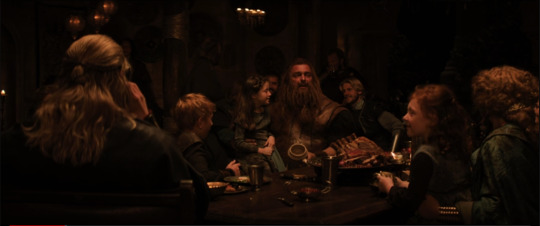
(The top image is from Thor's table flip scene in Thor 2011; while the one below it is from the tavern scene in the beginning of Thor: the Dark World.)
Meat, vegetables, fruit, grain, herbs, and seasonings are all represented on the tables above. While some might be imported (I really do wonder about the platters of golden apples myself:) it's not very likely all of them are. And it wouldn't make sense for them to have been imported from off world throughout their species development either. After all and again: they would have had to have survived and developed enough to GET TO, that stage in the first place.
You're also looking at Varnish in the shine of that table; smithing and metal working and ceramics in their table ware. Weaving either plant or animal fibers in their clothes, as well as the likely production of tannin (or it's equivalent) and leather working in every leather piece on screen. Candles can be made from varied sources, whether that's actual wax of some form, or condensed animal fat.
Oh, and if you find the enlarged version of those images: you'll also notice things like fine engraving and metal sculpture to the goblets and platters on the Thor 2011 table in particular.
Either way, the images above show us directly that unsurprisingly, they have come to understand whole other sub-levels of production: before you even get to the high-tech and magic ends of any of that to be able to reproduce it in that modern era.
As another side note related to that: the booze alone is pretty telling as to how far off the "Loki" series is on this mark, as well.
Creators of current content 'conveniently forgot' that this is supposed to be a space faring, technologically advanced society (even if they're the social equivalent of medieval imperialist thugs .. lol sorry not sorry! That's literally how they're depicted... and honestly that really weird twist IS some of Asgard's most interesting and strange development) whose friends, allies and other examples of places visited DO and HAVE included Earth, Xandar, and six other 'realms' as their etymology names them: for literal millennia.
Even taking the other, long established cultural influences and visitations aside? For a society who 5000 years ago was still porting whole armies to other planets to kick peoples asses?
The idea they never discovered honey; or sugar especially even on the inside of a fermentation barrel for wine; OR how to process it into something like candy? Is more than just a -little- dumb in the stretch. Sugar often naturally starts to separate and crystallize during the fermentation process. Ask a vintner, or look it up if you don't believe me.
Just sayin'.. just on Earth alone, we know sweets were discovered more than 8000 years ago. Eight thousand. And the only reason we haven't been able to confirm people older than that finding things like bee's hives?? Is because well.. that kind of thing rarely survives even that length of time at all, to be found in archeology in order to tell us more.
I'll touch that and how it's pretty damned near impossible that 'Loki doesn't know wtf candy is' being 1k+ years himself, and a guy raised as an Asgardian prince & spymaster to boot later into the culture section I think, but mmm.. that whole bit still reeks of stupid, to me
And more so after their own DB Cooper scene. Gonna say candy wasn't a snack in that era either? Cause if so; I got big shocking news, for those who think so... XD
In closing.. for this part?
As far as the world of Asgard goes, we have only been allowed to see a very small part of it: and even then? It is still undoubtedly massively larger than even what's implied: and definitely capable of supporting it's comparatively small base population of less than 10k people.

(Odin's subterranean vault reference: exterior)
The only reason we don't see even more of it; is the fact that films have a limited time to give you everything, and the story focuses on the royal family from the get go. And they live, in the heart of Asgard's capital city... so we largely don't see as much of that as weirdo world building fans like me would absolutely love to see in the process... and frankly; they gave plenty enough to start us off with.
The films would have suffered for having too much more of that, rather than the stories they were trying to tell.

The same.. I would love to know more: and I do wish the current teams paid the previous ones more respect by using what was already there and expanding on it: instead of making mismatched new things up, as they went.
The early creative teams really knew what they were doing back then.
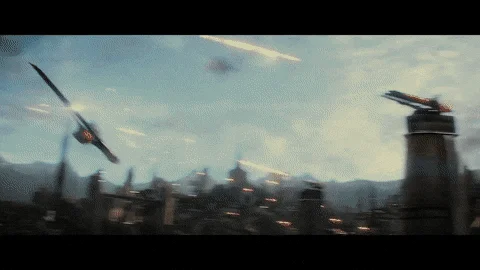
(Asgard's defensive cannons defending against the Darkalfheim air raid in Thor the Dark World.)
And no, this isn't all they showed us, in the show and tell they did manage to give us over the course of years of work... far from it.
Hope you enjoyed part one! Maybe you learned or saw something you missed.. or have been inspired to watch the older films again..?

I know I often am.
#MCU#Asgard#MCU Asgard#Lore drops#research#scene dissection#location and culture dissection#world building#universe building#Lokiverse references#writing references#writing research#Youtube#MCU Lore#part one:#about the land more than the people on it#don't worry: we'll get to that#:3
40 notes
·
View notes
Text
ᴡʀɪᴛɪɴɢ ʀᴇꜱᴏᴜʀᴄᴇꜱ - ʟɪɴᴋꜱ
word count + tracking progress - nanowrimo
-> "Writing a novel alone can be difficult, even for seasoned writers. NaNoWriMo helps you track your progress, set milestones, connect with other writers in a vast community, and participate in events that are designed to make sure you finish your novel. Oh, and best of all, it’s free!"
every name on this planet - fantasy name generators
-> "There are over 1400 name generators, as well as many description generators, guides and various tools you might find helpful. "
simplify your writing - Hemingway editor
-> The app highlights complex sentences and offers helpful suggestions (sorry, Grammarly).
understanding words - vocabulary
-> "Whether you’re looking up a specific word or just browsing, you’ll find a universe of friendly explanations and fun activities designed to educate and entertain."
focus / pomodoro timer - pomofocus
-> "The Pomodoro Technique is a time management method developed by Francesco Cirillo in the late 1980s. It uses a kitchen timer to break work into intervals, typically 25 minutes in length, separated by short breaks."
focus writing - zenpen
-> "A minimalist writing zone, where you can block out all distractions and get to what's important. The writing!"
writing prompts / feedback / contest - reedsy prompts
-> "Join (probably?) the world's largest writing contest. Flex those creative muscles with weekly writing prompts."
write 3 pages / day - 750 words
-> Learn to habit-write, and get results + information on your writing consistency, speed, distractions, etc. The goal is 750 words—three pages.
black market information - havocscope
-> "Havocscope provides information and threat intelligence on the global black market. Due to the ability of transnational threats to cause financial losses and social harms, key statistics and data about the illegal economy is provided to help mitigate this risk. The information about the black market has been collected from government agencies, academic studies, media reports, and reported data from our sources."
baby character names - nameberry
-> "Baby names by the experts at Nameberry, including popular names and unique names, baby girl names and baby boy names and gender neutral names too. We've got baby name lists, news and a revolutionary name generator. It's more than a name, it's an identity."
#writing resources#writerblr#lyralit#creative writing#writers#writers block#writing reference#writing references#wip
616 notes
·
View notes
Text
For all of you who want to use this (or those who don't necessarily want it, but really really need it):
I made a Guide to Bucky as an Amputee (link will be in a reblog because Tumblr is not working with me today...)
I do not have a limb difference so it's all based on research I've done myself and there is no personal experience on my hand. But since so many writers seem to not know where to start when it comes to Bucky as an amputee I thought I might as well share what I've found over the years...
As I also state in the document itself, this is merely a beginner's guide, I implore you to do your own additional research too!
If anyone with more personal knowledge has any pointers you can either comment them directly in the document or send me a private message on the hellsite! I'm open to learning more!
#fanfiction#disabled bucky barnes#bucky barnes#disability#disabled#fanfic references#writing references#disability references
173 notes
·
View notes